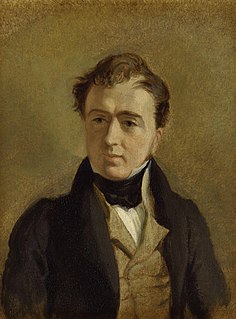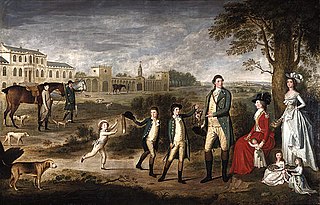
Marquess of the County of Bute, shortened in general usage to Marquess of Bute, is a title in the Peerage of Great Britain. It was created in 1796 for John Stuart, 4th Earl of Bute.

Earl of Stair is a title in the Peerage of Scotland. It was created in 1703 for the lawyer and statesman John Dalrymple, 2nd Viscount of Stair.

Baron Northbrook, of Stratton in the County of Southampton, is a title in the Peerage of the United Kingdom. It was created in 1866 for the Liberal politician and former Chancellor of the Exchequer, Sir Francis Baring, 3rd Baronet. The holders of the barony represent the genealogically senior branch of the prominent Baring family. The name Northbrook is derived from a tithing of the local parish.

Earl of Carhampton was a title in the Peerage of Ireland. It was created in 1785 for Simon Luttrell, 1st Viscount Carhampton. He had already been created Baron Irnham, of Luttrellstown in the County of Dublin, in 1768 and Viscount Carhampton, of Castlehaven in the County of Cork, in 1781, also in the Peerage of Ireland. He was the son of Henry Luttrell. Lord Carhampton was succeeded by his eldest son, the second earl. He was a general in the British Army and served as the commander-in-chief of Ireland from 1796 to 1798. He was childless and was succeeded by his younger brother, the third earl. He was a captain in the Royal Navy and also sat as Member of Parliament for Stockbridge. He married as his first wife the Honourable Elizabeth Olmius, daughter of John Olmius, 1st Baron Waltham, and assumed in 1787 by royal licence the additional surname of Olmius. Lord Carhampton had no sons and the titles became extinct on his death in 1829. Already the same year George IV offered to revive the earldom in favour of Sir Simeon Stuart, 5th Baronet, son of Sir Simeon Stuart, 4th Baronet, and his wife Lady Frances Maria, daughter of the third earl. However, the offer was declined.

There have been seven baronetcies created for members of the Lowther family, one in the Baronetage of Nova Scotia, two in the Baronetage of England, two in the Baronetage of Great Britain and two in the Baronetage of the United Kingdom. Two of the creations are extant as of 2008.
There have been two baronetcies created for persons with the surname Hobart, one in England and one in the United Kingdom.

The Fergusson Baronetcy, of Kilkerran in the County of Ayr, is a title in the Baronetage of Nova Scotia. It was created on 30 November 1703 for the prominent advocate John Fergusson. The second Baronet represented Sutherland in the House of Commons and served as a Lord of Session under the judicial title Lord Kilkerran. The third Baronet sat as Member of Parliament for Ayrshire and Edinburgh. In 1796 he claimed the earldom of Glencairn. The House of Lords decided that he had successfully proved that he was heir-general to Alexander Cunningham, 10th Earl of Glencairn, but that he had not proved his right to the earldom. The sixth Baronet was a Conservative politician and colonial governor and notably served as Governor of New Zealand from 1873 to 1874 and as Governor of Bombay from 1880 to 1885. The seventh Baronet was Governor-General of New Zealand between 1924 and 1930. The eighth Baronet was an author and historian and also served as Lord-Lieutenant of Ayrshire.
There have been two baronetcies created for persons with the surname Colquhoun ("Cohoon"), one in the Baronetage of Nova Scotia (1625) and one in the Baronetage of Great Britain (1786).
Nineteen baronetcies have been created for persons with the surname Hamilton, eight in the Baronetage of Nova Scotia, one in the Baronetage of England, five in the Baronetage of Ireland, one in the Baronetage of Great Britain and four in the Baronetage of the United Kingdom. As of 2008 two creations are extant, two are dormant, two are either extinct or dormant and twelve extinct.

There have been five baronetcies of the United Kingdom created for a person with the surname Erskine, two in the Baronetage of Nova Scotia, one in the Baronetage of Great Britain and two in the Baronetage of the United Kingdom. Two of the creations are extant as of 2010.
There have been ten baronetcies created for persons with the surname Mackenzie, seven in the Baronetage of Nova Scotia and three in the Baronetage of the United Kingdom. Four of the creations are extant as of 2010.
There have been five Baronetcies created for people with the surname Forbes, four in the Baronetage of Nova Scotia and one in the Baronetage of the United Kingdom. The first holder of the Burn Baronetcy of Jessfield, created in the Baronetage of the United Kingdom in 1923, assumed the surname of Forbes-Leith of Fyvie in 1925.

There have been seventeen baronetcies for persons with the surname Stewart, ten in the Baronetage of Nova Scotia, one in the Baronetage of Ireland and six in the Baronetage of the United Kingdom. See also Steuart baronets, Henderson-Stewart baronets, MacTaggart-Stewart baronets and Stewart-Clark baronets.
There have been seven baronetcies created for persons with the surname Sinclair, six in the Baronetage of Nova Scotia and one in the Baronetage of Great Britain. Four of the creations are extant as of 2008.
There have been four baronetcies created for persons with the surname Seton, all in the Baronetage of Nova Scotia. As of 2008 one creation is extant, one dormant and two extinct.
There have been five baronetcies created for persons with the surname Home, four in the Baronetage of Nova Scotia and one in the Baronetage of the United Kingdom. Only one creation is extant as of 2008.
There have been three baronetcies created for persons with the surname Maitland, two in the Baronetage of Nova Scotia and one in the Baronetage of the United Kingdom. Two of the creations are extant as of 2008 while the other is either dormant or extinct.

There have been five baronetcies created for persons with the surname Kennedy, one in the Baronetage of Ireland, three in the Baronetage of Nova Scotia and one in the Baronetage of the United Kingdom. One creation is extant as of 2010.
There have been three Keith Baronetcies.
Captain John Luttrell-Olmius, 3rd Earl of Carhampton, styled The Honourable John Luttrell between 1768 and 1787 and as The Honourable John Luttrell-Olmius between 1787 and 1829, was an Irish naval commander and politician who sat in the House of Commons between 1774 and 1785.